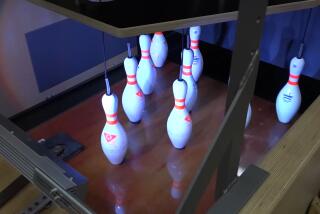Show Disenchantment of Americans, He Says : Sociologist Trashes ‘Trash Sports’
- Share via
SANTA CLARA, Calif. — “Trash sports,” zany challenges that range from beer chug-a-lugging to Evel Knievel’s motorcycle stunts, show that Americans are losing the ability “to discriminate between good and bad,” a sociologist says.
“Trash sports involve all those so-called athletic events you generally see on television shows like ‘That’s Incredible,’ and ‘Real People,’ ” said John Sewart of the University of Santa Clara.
In addition, the long list includes “belly-bucking,” roller derby and mud wrestling.
Sewart and a colleague, Paul Verden, are studying trash sports and hope to have a book out on the subject next year.
Long Part of Culture
Such competitions have always been a part of American’s culture, Sewart said, pointing to the flagpole sitting and dance marathon crazes of the 1920s and 1930s.
“I’d even go as far back as ancient Rome and include the gladiatorial combats under the heading,” he said. “However, there’s a big difference now. Television can create these sports almost overnight.”
Even more importantly, he said, trash sports show a profound disenchantment in the lives of many Americans.
“There’s a deeply felt need to escape from the meaninglessness in our lives today,” he said. “Many people feel a lack of rootedness, a lack of direction.”
Lack of Standards
“We no longer have commonly agreed-upon standards; ‘anything goes’ seems to be our motto. As a result, we’re bombarded daily with these diversions, and we are losing our ability to discriminate between good and bad.”
The two sociologists ran across some strange competitions during their study.
“One of our favorites was Frank (Cannonball) Richards,” Verden said. “He toured the country in the 1960s letting people fire a cannonball at his stomach. He wasn’t killed, but we think he did take early retirement.”
Chug-a-Lugging
In one contest, the competitors ran from bar to bar, chug-a-lugging 16-ounce beers at each of six or eight bars.
“The winner, I presume, is the one still left on his feet,” Verden said.
Sewart was fascinated by such oddball antics even before he became a sociologist.
“I grew up in Antioch (Calif.) and when I was in high school we’d have contests to see who could knock himself out first with just his fist. We had judges and everything.”
More to Read
Go beyond the scoreboard
Get the latest on L.A.'s teams in the daily Sports Report newsletter.
You may occasionally receive promotional content from the Los Angeles Times.










